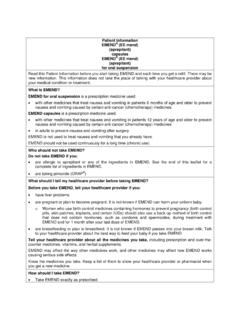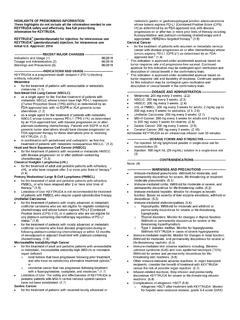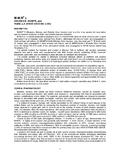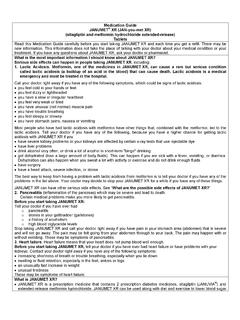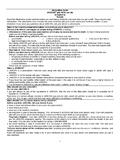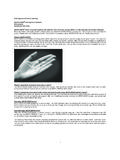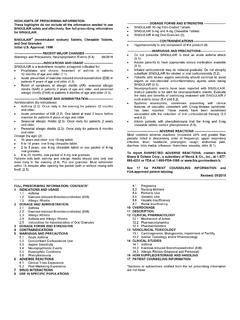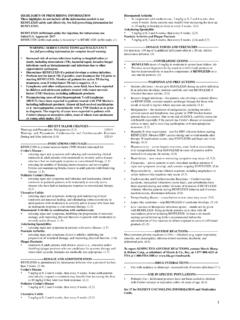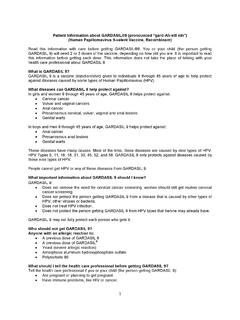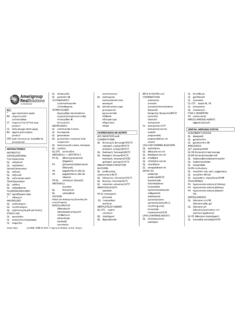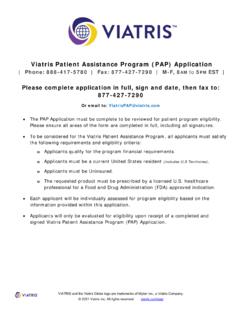Transcription of HIGHLIGHTS OF PRESCRIBING INFORMATION ... - Merck & Co.
1 1 HIGHLIGHTS OF PRESCRIBING INFORMATIONT hese HIGHLIGHTS do not include all the INFORMATION needed to use TEMODAR safely and effectively. See full PRESCRIBING INFORMATION for (temozolomide) CapsulesTEMODAR (temozolomide) for Injectionadministered via intravenous infusionInitial Approval: 1999----------------------------INDICATI ONS AND USAGE----------------------------TEMODAR is an alkylating drug indicated for the treatment of adult patients with: Newly diagnosed glioblastoma multiforme (GBM) concomitantly with radiotherapy and thenas maintenance treatment. ( ) Refractory anaplastic astrocytoma patients who have experienced disease progression on a drug regimen containing nitrosourea and procarbazine.
2 ( )-----------------------DOSAGE AND ADMINISTRATION----------------------- Newly Diagnosed GBM: 75 mg/m2for 42 days concomitant with focal radiotherapy followed by initial maintenance dose of 150 mg/m2once daily for Days 1-5 of a 28-day cycle of TEMODAR for 6 cycles. ( ) Refractory Anaplastic Astrocytoma: Initial dose 150 mg/m2once daily for 5 consecutive days per 28-day treatment cycle. ( ) The recommended dose for TEMODAR as an intravenous infusion over 90 minutes is the same as the dose for the oral capsule formulation. Bioequivalence has been established only when TEMODAR for Injection was given over 90 minutes. ( , )---------------------DOSAGE FORMS AND STRENGTHS--------------------- 5-mg, 20-mg, 100-mg, 140-mg, 180-mg, and 250-mg capsules.
3 (3) 100-mg powder for injection. (3)-------------------------------CONTRA INDICATIONS----------------------------- -- Known hypersensitivity to any TEMODAR component or to dacarbazine (DTIC). ( )-----------------------WARNINGS AND PRECAUTIONS------------------------ Myelosuppression monitor Absolute Neutrophil Count (ANC) and platelet count prior to dosing and throughout treatment. Geriatric patients and women have a higher risk of developing myelosuppression. ( ) Cases of myelodysplastic syndrome and secondary malignancies, including myeloid leukemia, have been observed. ( ) Pneumocystis pneumonia (PCP) PCP prophylaxis required for all patients receiving concomitant TEMODAR and radiotherapy for the 42-day regimen for the treatment of newly diagnosed glioblastoma multiforme.
4 ( ) All patients, particularly those receiving steroids, should be observed closely for the development of lymphopenia and PCP. ( ) Complete blood counts should be obtained throughout the treatment course as specified. ( ) Hepatotoxicity fatal and severe hepatotoxicity have been reported. Perform liver function tests at baseline, midway through the first cycle, prior to each subsequent cycle, and approximately two to four weeks after the last dose of TEMODAR. ( ) Fetal harm can occur when administered to a pregnant woman. Women should be advised to avoid becoming pregnant when receiving TEMODAR. ( ) As bioequivalence has been established only when given over 90 minutes, infusion over a shorter or longer period of time may result in suboptimal dosing; the possibility of an increase in infusion-related adverse reactions cannot be ruled out.
5 ( )------------------------------ADVERSE REACTIONS------------------------------ The most common adverse reactions ( 10%incidence) are: alopecia, fatigue, nausea, vomiting, headache, constipation, anorexia, convulsions, rash, hemiparesis, diarrhea, asthenia, fever, dizziness, coordination abnormal, viral infection, amnesia, and insomnia. ( ) The most common Grade 3 to 4 hematologic laboratory abnormalities ( 10% incidence) that have developed during treatment with temozolomide are: lymphopenia, thrombocytopenia, neutropenia, and leukopenia. ( ) Allergic reactions have also been reported. (6)To report SUSPECTED ADVERSE REACTIONS, contact Merck Sharp & Dohme Corp., a subsidiary of Merck & Co.
6 , Inc., at 1-877-888-4231or FDA at 1-800-FDA-1088 or INTERACTIONS---------------------------- --- Valproic acid: decreases oral clearance of temozolomide. ( )-----------------------USE IN SPECIFIC POPULATIONS----------------------- Nursing mothers: Not recommended. ( ) Pediatric use: No established use. ( ) Hepatic/Renal Impairment: Caution should be exercised when TEMODAR is administered to patients with severe renal or hepatic impairment. ( , )See 17 for PATIENT COUNSELING INFORMATION and FDA-approved patient : 10/2017 FULL PRESCRIBING INFORMATION : CONTENTS*1 INDICATIONS AND Newly Diagnosed Glioblastoma Refractory Anaplastic Astrocytoma2 DOSAGE AND Recommended Dosing and Dose Modification Preparation and Administration3 DOSAGE FORMS AND STRENGTHS4 Hypersensitivity5 WARNINGS AND Myelodysplastic Laboratory Use in Infusion Time6 ADVERSE Clinical Trials Postmarketing Experience7 DRUG Valproic Acid8 USE IN SPECIFIC Nursing Pediatric Geriatric Renal Hepatic Impairment10 OVERDOSAGE11 DESCRIPTION12 CLINICAL Mechanism of Pharmacokinetics 13 NONCLINICAL Carcinogenesis, Mutagenesis.
7 Impairment of Animal Toxicology and/or Pharmacology14 CLINICAL Newly Diagnosed Glioblastoma Refractory Anaplastic Astrocytoma15 REFERENCES16 HOW SUPPLIED/STORAGE AND Handling and PATIENT COUNSELING INFORMATION2*Sections or subsections omitted from the full PRESCRIBING INFORMATION are not PRESCRIBING INFORMATION1 INDICATIONS AND Diagnosed Glioblastoma MultiformeTEMODAR (temozolomide) is indicated for the treatment of adult patients with newly diagnosed glioblastoma multiforme concomitantly with radiotherapy and then as maintenance Anaplastic AstrocytomaTEMODAR is indicated for the treatment of adult patients with refractory anaplastic astrocytoma, , patients who have experienced disease progression on a drug regimen containing nitrosourea and AND Dosing and Dose Modification GuidelinesThe recommended dose for TEMODAR as an intravenous infusion over 90 minutes is the same as the dose for the oral capsule formulation.
8 Bioequivalence has been established only when TEMODAR for Injection was given over 90 minutes [see Clinical Pharmacology ( )]. Dosage of TEMODAR must be adjusted according to nadir neutrophil and platelet counts in the previous cycle and the neutrophil and platelet counts at the time of initiating the next cycle. For TEMODAR dosage calculations based on body surface area (BSA) see Table 5. For suggestedcapsule combinations ona daily dose seeTable with Newly Diagnosed High Grade Glioma: Concomitant Phase:TEMODAR is administered at 75 mg/m2daily for 42 days concomitant with focal radiotherapy (60 Gy administered in 30 fractions) followed by maintenance TEMODAR for 6 cycles. Focal RT includes the tumor bed or resection site with a 2- to 3-cm margin.
9 No dose reductions are recommended during the concomitant phase; however, dose interruptions or discontinuation may occur based on toxicity. The TEMODAR dose should be continued throughout the 42-day concomitant period up to 49 days if all of the following conditions are met: absolute neutrophil count greater than or equal to x 109/L, platelet count greater than or equal to 100 x 109/L, common toxicity criteria (CTC)nonhematological toxicity less than or equal to Grade 1 (except for alopecia, nausea, and vomiting). During treatment a complete blood count should be obtained weekly. Temozolomide dosing should be interrupted or discontinued during concomitant phase according to the hematological and nonhematological toxicity criteria as noted in Table 1.
10 Pneumocystis pneumonia (PCP)prophylaxis is required during the concomitant administration of TEMODAR and radiotherapy, and should be continued in patients who develop lymphocytopenia until recovery from lymphocytopenia (CTC Grade less than or equal to 1).TABLE 1: Temozolomide Dosing Interruption or Discontinuation During Concomitant Radiotherapy and TemozolomideToxicityTMZ Interruption*TMZ DiscontinuationAbsoluteNeutrophil Countgreater than or equal to and less than x 109/Lless than x 109/LPlatelet Countgreater than or equal to 10 and less than 100 x 109/Lless than 10 x 109/LCTC Nonhematological Toxicity(except for alopecia, nausea, vomiting)CTC Grade 2 CTC Grade 3 or 4*Treatment with concomitant TMZ could be continued when all of the following conditions were met: absolute neutrophil count greater than or equal to x 109/L; platelet count greater than or equal to 100 x 109/L.
